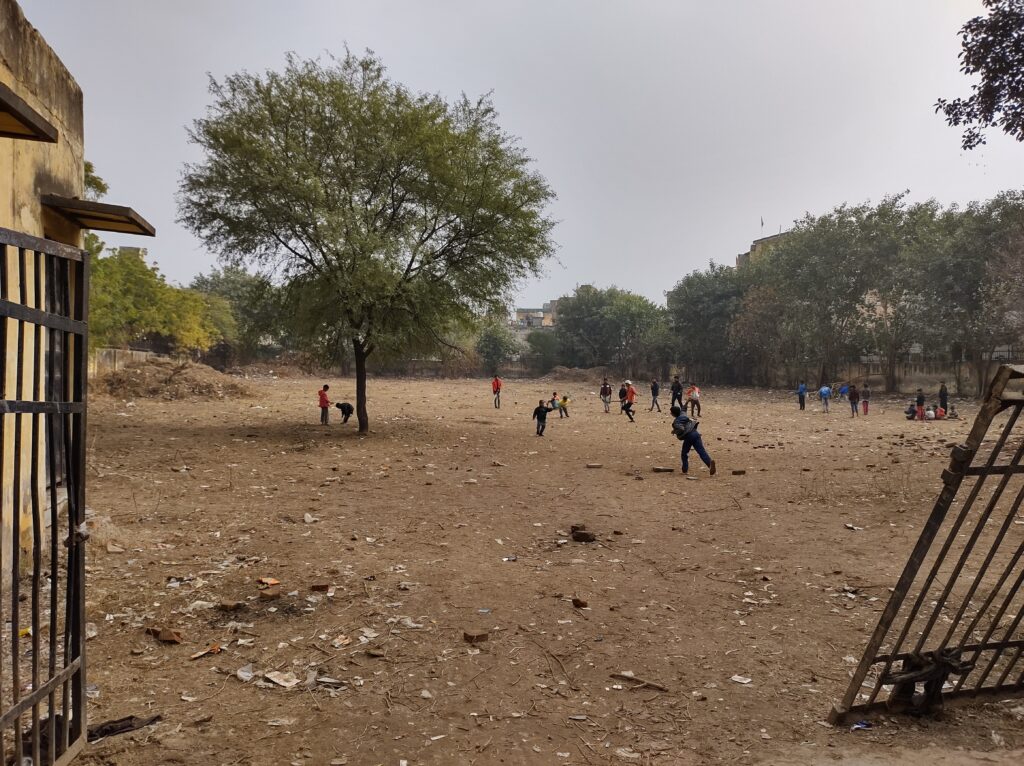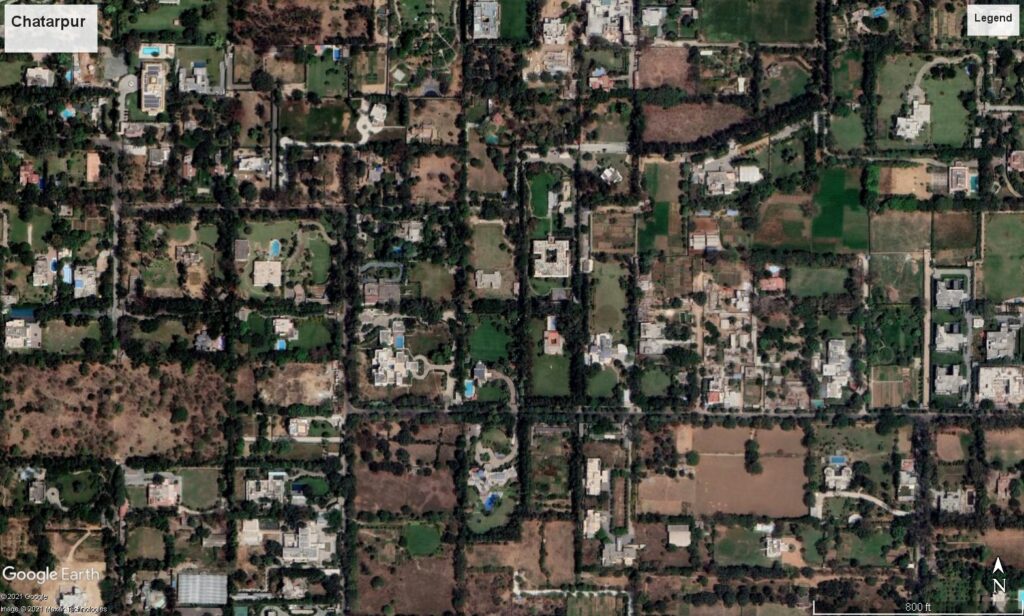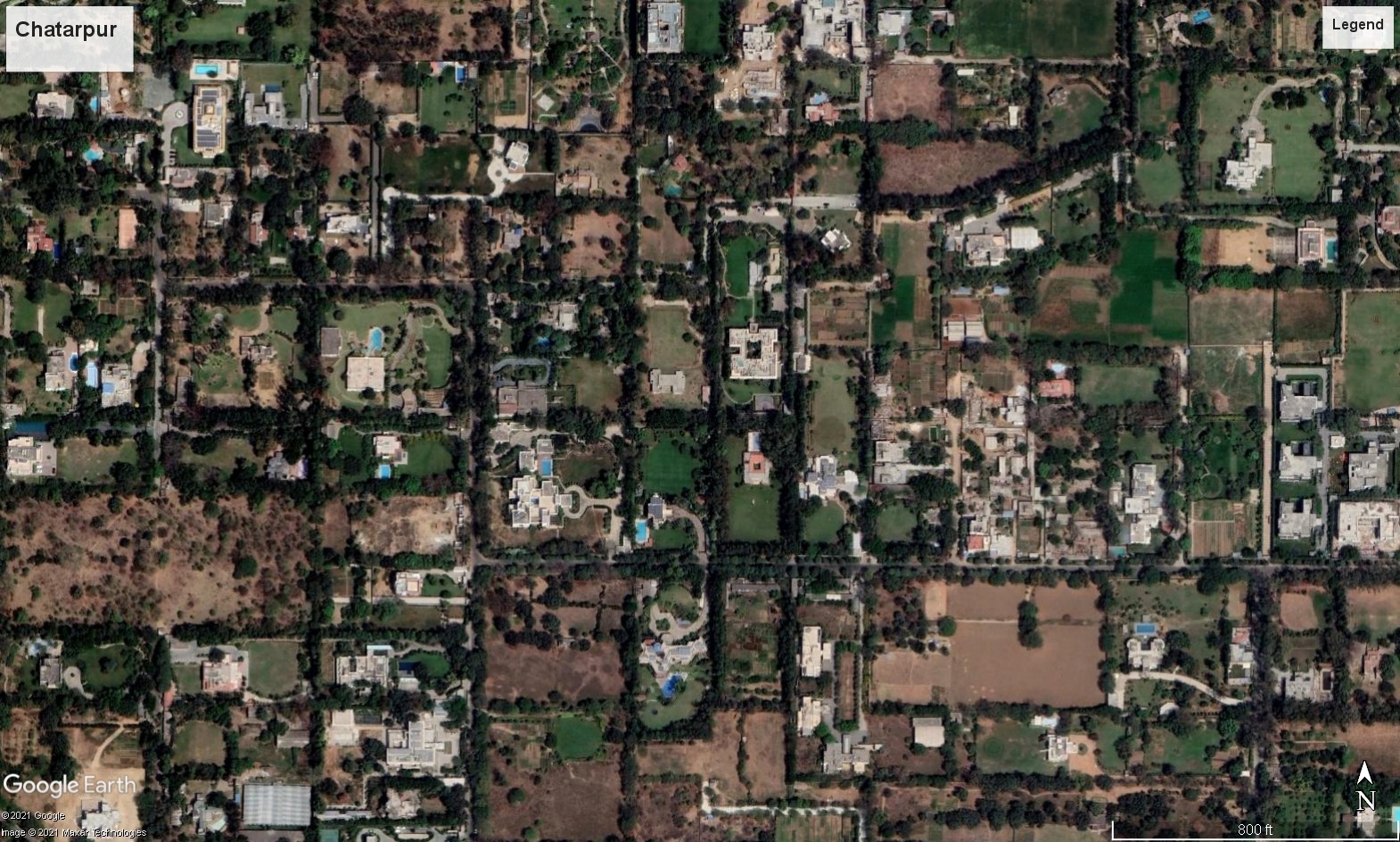This is the second article of a two-part series on the disappearing commons and evictions in Delhi’s lal dora villages. To read part one, click here.
Last year, a group of residents from southwest Delhi’s Pandwala Khurd, a lal dora village made a disturbing discovery. “We found that almost 44 acres of Gram Sabha land [which were] originally set aside for the grazing purposes of every resident had been transferred to the Delhi Development Authority (DDA),” shares Rohtas, a resident of Pandwala Khurd. Lal dora are villages whose areas were demarcated almost a century ago—and are now expected to grow only within those limits. With this transfer of land to the DDA, multistoried flats, a residential housing complex, a community centre—any of these could be built on these common lands.
Such development is a possibility. The Bastion collated data from Delhi government’s Revenue Department website and found that as of March 2014, almost 7,400 acres of Gram Sabha land, or village commons, has been allocated to various government departments like Transport, Delhi Jal Board, Municipal Corporation of Delhi, and the DDA. As the documents suggest, these land allocations have been made for wide-ranging reasons, from raising high-income residential colonies (like DDA’s Rohini Residential Scheme), to industrial complexes, farm houses, and even tree plantations.
Such privatisation of commons worries the residents of other lal dora villages as well. “If tomorrow an apartment complex comes up on our common lands, of course, none of the villagers will be able to buy a flat there. Then why should we have to give up our land for it? We would rather have the Gram Sabha land be used by our own people for common purposes, or have people from our village living on it,” says Rajesh Dabas, a resident of Ladpur, another lal dora village.

In fact, in both Rohtas’ and Dabas’ villages, the commons are used as living spaces by the villagers. Devoid of choice (and land) given their status as lal doras, their villages slowly ate into the Gram Sabha lands, thereby awarding all those who built here with the tag of “encroacher” by the Delhi government and DDA.
Like the first instalment of this two-part series suggests, the East Punjab Holding (Consolidation and Prevention of Fragmentation) Act of 1948 could have avoided the creation of “encroachers” in the city. Apart from the compulsory consolidation of fragmented agricultural holdings, the Act also provides for the extension of abadi or living areas of the villages, which creates more space for legal residences. Alongside the Delhi Holdings Rules, if this Act were implemented in the lal dora villages (using agricultural land) when communities demanded it, many residences could be legalized.
Yet now termed as encroachers, people living on Gram Sabha lands have faced evictions and demolitions instead, in order to ease the apparent pressure on land in the national capital. After all, Delhi seems to have a “limited availability of land,” as per Delhi’s Master Plan 2041, which advocates for “small format housing of 40-60 square feet.” It does not help that the city is currently the world’s second-most populous urban agglomeration, on its way to occupy the top position by 2028, with 37.2 million people expected to reside in the capital.
In such a scenario, Gram Sabha lands are possibly the last few spaces available for common use in a crowded city. But, these are already under threat: land is now being “developed” to meet the demands of the national capital, and with the help of the State, common Gram Sabha lands are on their way to being privatised and made available to only those who can afford it. So, along with the privatisation of Delhi’s commons, will such land consolidation—which legalises unplanned residences—worsen the plight of commons in the city?
Ensuring Commons Through Consolidation
“At the end of the day, land consolidation is an adjustment between farmers and the administration. In Ladpur, for instance, the farmers have argued that in the process of exchanging 2 units of their agricultural land for 1 unit of residential land [an exchange that Delhi Holdings Rules allow for], they are willing to give up some proportion of their farmland that can be commonly used by all,” says Paras Tyagi, founder of the NGO CYCLE.
Residents of Ladpur did not make this suggestion out of thin air. Through the step of muzarai, the Delhi Holding Rules ensure that such commonly used spaces do not disappear post-consolidation. Deployed in villages where there is limited common land, muzarai involves a compulsory deduction of some part of the total consolidated land for common purposes, thereby allowing for the commons to be retained. “When adequate Gaon [Gram] Sabha land is not available in the village for common purpose,” the Rules suggest, “the maximum “Muzarai” that may be deducted shall be two biswas per bigha [roughly 3,450 square feet for every acre of land].”
“The common land that can be made available through muzarai can be used for any common purpose, be it building roads, a hospital, parking area, or a park,” shares Dabas. This, of course, would require the difficult task of residents being on the same page of giving up land for the benefit of the village’s common needs. In Ladpur, this solidarity seems possible, particularly in the aftermath of when the village took to the Delhi High Court a decade ago, to expedite the village’s consolidation process. In 2011, the Court ruled in their favour.
“Preparing a court case was an expensive affair which no individual could have individually supported. Apart from a few individuals, our entire village contributed towards the costs, even if it was as little as ₹10,” he adds. The village’s unity on the matter also reflected in the 2012 civic election when all of Ladpur’s 4,200 registered voters boycotted the elections, as no consolidation work had begun post the 2011 judgement in its favour.
“Everyone from our village who supported the consolidation has agreed with the muzarai process,” Dabas reiterates. But, what is being proposed here to keep the commons protected, has threatened the forests of the Aravallis in Haryana, hinting towards the double-edged sword this land consolidation process can be.
Consolidation, the Double-Edged Sword
In 2019, the Haryana government ordered the consolidation of about 3,000 acres of Aravalli land in Kot Village, Faridabad. The government gathered several small holdings of “uncultivable land” and “shyamlat” (village commons) scattered across a large area. When this news reached the locals and environmentalists, they got the hint that this consolidation was to accelerate the privatisation of commons in the area. And they were right: the consolidation was accompanied by an amendment to the Punjab Land Preservation Act, 1990, which opened up thousands of previously protected acres of land in the Aravallis to development.
Soon after, the news of the Patanjali group (and other dealers) having acquired 400 acres of forested commons in the same area broke, a transaction that allegedly took place between 2014 and 2016. Common lands had been privatised right under the noses of Kot’s residents, a problem that they saw coming.

Patanjali’s takeover of common lands is also a reminder to revisit who should be taking the blame for increasing pressure on Delhi’s forests, commons, and lands. The various departments of the Delhi government dealing with land have often suggested that densely built housing complexes on the commons—which are often built by low-income Delhiites—seem to be the greatest threat to the city’s diminishing land. This becomes even more relevant where Gram Sabha lands are being transferred for non-commons purposes—which is where high-end hotels and farmhouses in Delhi’s urban villages come into the picture.
Land Scarcity, a Myth?
“In Delhi’s villages, where expansion was not allowed, a sense of ‘scarcity’ of land will be felt because the residents [there] have had no other choice but to build cramped housing,” says Manju Menon, a Senior Fellow at the Centre for Policy Research working on issues of environmental justice and the politics of resource rights. “But, as a whole, this notion of land scarcity in Delhi hides the bigger issues of how the land is distributed and made available for the diverse needs of different sections of society. If land allocation is not done according to ground realities, then urban land use laws are meaningless and cannot be followed. Eviction follows, and in the process, people who have the least resources lose all their investments.”
An analysis by CYCLE and Delhi Dehaat, a voluntary collective of youth from Delhi’s urban and rural villages, shows how skewed the distribution of land is in the city. In South Delhi’s Chattarpur—which is technically a village, but better known for its sprawling farmhouses with swimming pools and winding driveways—32% (or 115 acres) of the land is owned by individuals who are not residents of the village, such as the owners of the farmhouses. A much smaller 18% of Chattarpur’s land is used for residential purposes by village residents. The rest is divided between farming land and Gram Sabha lands.

This analysis of 194 Delhi villages further reveals that while 49% of the land is shared between 1.28 lakh village residents for residential purposes, 28% is currently owned by a little over 50,000 non-residents. The remaining 23% is under the ownership of Gram Sabha and agricultural land. It is then clear that the per-capita ownership of land is slightly higher for non-residents, which reinforces the need for them to also share the blame of land pressure.
And yet, it is often the low-income Delhiites who face evictions. “If you think about it, Delhi’s largest encroachment is possibly Sainik Farms, which is one of the city’s poshest residential colonies,” mentions a government official who requested anonymity. “But of course, there you will not see any demolitions, because they have the negotiating power, which a shanty or other lower income residents may not have. Such large scale demolitions are much more frequent [in low-income areas], and often this is because of political pressure at the top.”
As Menon has co-written before, the human cost per acre of removing such sprawling bungalows and farmhouses would be much lesser than that of evicting people from dense housing, which is still, unfortunately, the path taken. The most recent example is the case of Khori Gaon in Faridabad, where over 6,500 houses are set to be demolished, all in a bid to protect the forests of the Aravallis. But as the authors show, the areas occupied by neighbouring religious institutions, hotels, and sports complexes are much, much higher compared to those being occupied by Khori Gaon’s residents.
Delhi may well be facing an increasing demand for land. But, the eviction of low-income homeowners—who encroached on commons only when their residential needs were not met—will not solve the land pressure problem. Instead, securing their residential needs should also be a priority. “Another important thing that should happen is a drop in land prices. If land prices go down, that will ensure more democratic ownership of land,” shares the government official, pointing towards the need of making land and accommodation affordable to all in the city. The official also mentioned the developing Delhi-Meerut Rapid Transit corridor. The estimated 82 kilometer long corridor aims to connect Delhi NCR to Uttar Pradesh, reducing distances between the two. As traveling to Delhi becomes easier and quicker, lesser people would have to move to the capital for work. The official hopes that the demand for housing from such populations who move for work will reduce with such developments.
Solutions to Delhi’s land ‘scarcity’ demand a larger understanding of land distribution and a better account of the city’s privatisation of commons. As the world’s second most populous city continues to grow, many of Delhi’s ‘encroachers’ might be left behind. Unless, for some villages—especially those that are demanding it—land consolidation through the East Punjab Holdings Act and Delhi Holdings Act can secure their residential demands.
Featured image: An aerial view of Chhatarpur’s farmhouses; map prepared by Vaishnavi Rathore.







Truly, good governance is an art, and deliberately creating public woes where only few with enormous amount of economic resources are allowed livable space(majority are black money hoarders and have already purchased ten to eleven lavish plots or flats). Government, controls the supply by exploiting the weak. This is cruel injustice. Either, compel people to not invest in property, which is artificially made to be scarce, by imposing higher taxes on the second property purchased or let the village people be given extended property rights in their ancestral property to sell it as residential. We know government has to stop the tendency to convert fertile land as residential units. But this much control is madness. In no decent country, a 40 square meter flat is accepted as a adequate enough a house fit for dignified human living. Politicians are bloody imbeciles and corrupt, both at the same time.
[…] Also Read: Finding Delhi’s “Encroachers”: The Lal Dora Investigation […]
[…] Finding Delhi’s “Encroachers”: The Lal Dora Investigation […]